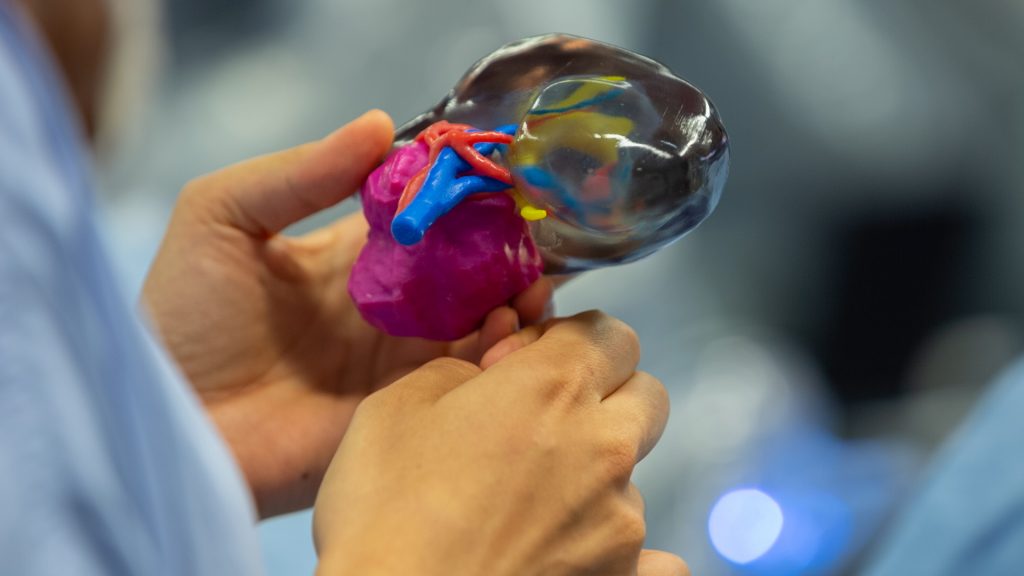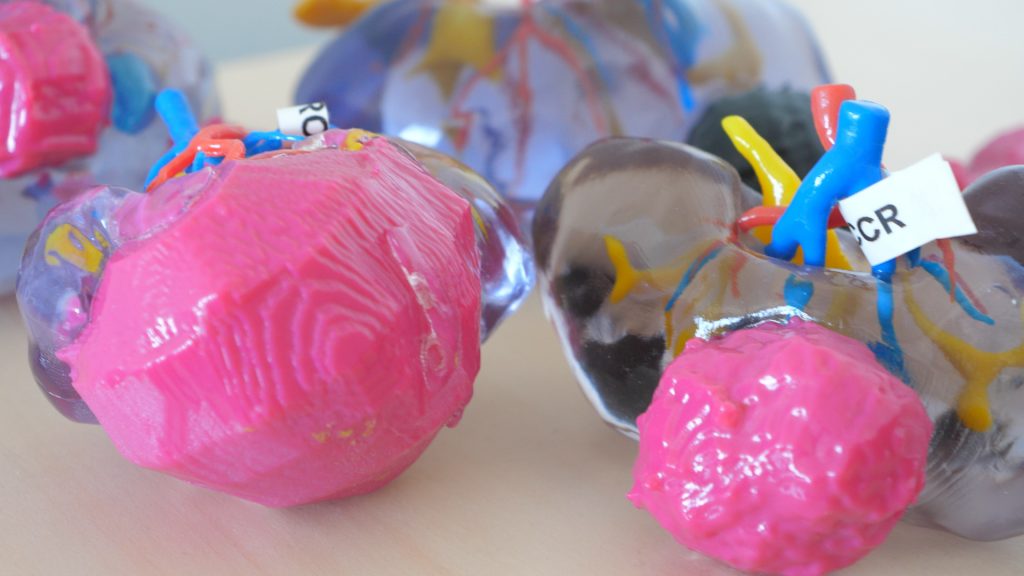The Centre Hospitalier Universitaire de Bordeaux (CHU de Bordeaux) has become one of the first hospitals in the world to add a Stratasys J750 to its facilities. Used by the surgical team at CHU de Bordeaux’s Department of Urology and Kidney Transplantation the system is being applied to fabricate full color, detailed organ models.
The overall goal of this 3D printer is to improve kidney tumor removal surgery by providing models for surgical planning, patient communication and training. So far, results of this plan have been encouraging, demonstrating that, on average, 3D printed models have helped patients understand their surgery up to 50% better than when using a simple 2D scan.
“Describing kidney tumor removal with a 2D scan or diagram will invariably leave most patients somewhat bewildered,” comments CHU de Bordeaux Professor Jean-Christophe Bernhard. “Presenting them with a 3D printed model that clearly shows the tumor puts them at ease and enables the patient to grasp exactly what we’re going to do.”
“Indeed,” he continues, “initial research from patient questionnaires shows that having 3D printed models increases their understanding of the surgery by up to 50%, so it’s a considerable benefit in terms of overall patient care.”

The Stratasys J750
The J750 3D printer has become a staple of the Stratasys product line since its launch in 2016. A full color, multi material PolyJet system, the machine produces high quality models with a combination of clear and opaque features. These capabilities have earned the machine a valuable place in applications that require clear communication and, as such, it has subsequently been validated for use in hospitals with Materialise’s FDA cleared Mimics inPrint software.
As of April 2019, the system has also been Pantone validated, meaning that the colors it produces can be be matched to the internationally recognized Pantone Matching System.

Improving patient care
The J50 was acquired by CHU de Bordeaux with funding from the European Union, the Regional Council of Nouvelle Aquitaine and the Bordeaux University Foundation. It’s first implementation at the hospital has been in a project named Rein 3D Print.
Rein 3D Print is a pilot protocol led by the department to determine whether 3D printed models can improve the understanding of patients receiving same-day surgery. Patient Carole Ridel is one of the first people to take part in the project. Explaining the process after having had her operation, Ridel that she “instantly felt more reassured” than she had in prior surgeries having seen the 3D printed model of her kidney. “Seeing such a realistic representation allowed me to understand the process much better than an MRI scan,” she adds. “I noticed that the tumors were on the external wall of the kidney, rather than inside the organ itself, so I was comforted by realizing the situation wasn’t as bad as I had imagined.”
In addition to Rein 3D Print, the CHU de Bordeaux team are looking at other areas where the technology can potentially improve patient care. On the one hand, Professor Bernhard explains, “Having a 3D printed model comprising the patient’s kidney tumor, main arteries and vessels – each in a different color – provides an accurate picture of what we will see during operations.”
In turn, he adds, “The ability to visualize the specific location of a tumor in relation to these other elements, all in three dimensions, greatly facilitates our surgical planning and is not easily achievable from a 2D scan.”
Such a clear image is especially valuable to the team when considering complex tumor surgeries, or training medical students in the process.
3D printing in hospitals
3D printed anatomical models are proving to be a valuable application in the medical industry. As such, a number of 3D printing industry stakeholders have begun to launch their own initiatives and services to give hospitals and clinicians access to these capabilities. Some hospitals, like CHU de Bordeaux, have also started growing their own in-house 3D printing facilities a movement indicative of the potential future offered to 3D printing in medicine.
Noting the rise in 3D printed anatomical models, in 2018 the Radiological Society of North America (RSNA) posted a set of guidelines, suggesting standard approaches to their production.

Subscribe to the 3D Printing Industry newsletter, like us on Facebook and follow us on Twitter for all the latest medical 3D printing news. Visit 3D Printing Jobs for new opportunities in additive manufacturing.
Featured image shows a 3D printed kidney tumor model used in pre-surgical planning. Photo via Stratasys


